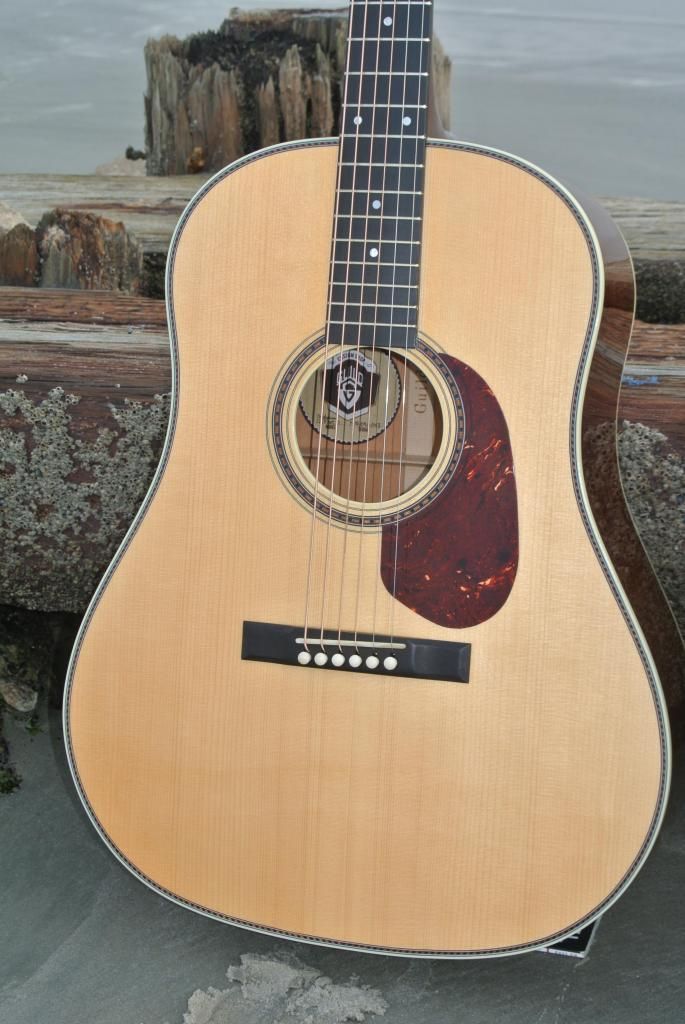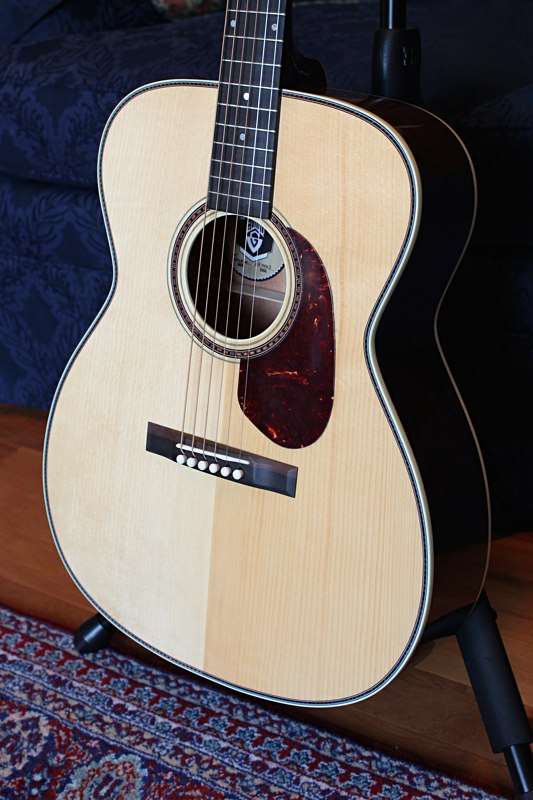I have over simplified the tap tuning process some. To add the missing pieces;
1. The top is tap tested after book matching, witj no braces at all. This serves to weed out top wood that may not be suitable for the intended guitar use. No use in putting on braces to a piece of wood that won't ever work out.
2. Braces are put on. They are of a nominal length, width, and height. Basic scallops are cut into the braces. The pattern and size/shape (height/width) are as per the builder's bracing pattern for that type/size guitar. Note that the brace surfaces that are glued to the top have the top curvature already formed. After all is dry, the top is again tap tested. This is where the brace carving, and shaping of the brace (how the brace tapers from the surface glued to the top to the bottom of the brace is shapedm and its height). This is where the experience of the hand builder comes in. Where to scallop, where to taper, and how much can be scalloped and shaped off so that the guitar doesn't collapse from string tension is in the hands, ears, and the eyes of the hand builder, as well as what they are looking for in the tap tones. The intent is to get the top/braces to the correct tonal response, keeping in mind the tone will change when the top is joined to the sides, so a tone that will result in the desired tone after the guitar top is joined to the sides. Sort of pre-compensating the top to get the final tone after the top is joined to the sides..
3. The top is then joined to the back and sides. Again, the tap tuning process is repeated. Every time that the top is changed (from book matched, to braced, to joined to the sides (which serves to add some stiffness to the top)) the tap tuning is repeated. There is only going to be some fairly minor tuning done here as most of the top's tone has been established in step 2. If step 2 was done fairly well, there may not be any material removal at all. This should result in a tone that is very close to the final tone required.
4. Guitar is assembled, and finished. After the guitar finish hardens, the top is tap tested again. In many/most cases, there will not be any tuning required, in some cases there will be.
5. Guitar is strung up with the specified strings, and then tested by playing it, again looking to hear the correct tone. As well, the other parts of the guitar are checked out (intonation, neck releif, saddles/nuts adjusted, look for dead spots on the neck, overall finish check, etc.)
Factories don't do this because it is too time consuming, and because you would need each and every employee to have the skills of a hand builder )i.e. a Ren Ferguson), which is not practical, or even possible. This is why hand built guitars sound the way that they do, and why they cost as much as they do.
1. The top is tap tested after book matching, witj no braces at all. This serves to weed out top wood that may not be suitable for the intended guitar use. No use in putting on braces to a piece of wood that won't ever work out.
2. Braces are put on. They are of a nominal length, width, and height. Basic scallops are cut into the braces. The pattern and size/shape (height/width) are as per the builder's bracing pattern for that type/size guitar. Note that the brace surfaces that are glued to the top have the top curvature already formed. After all is dry, the top is again tap tested. This is where the brace carving, and shaping of the brace (how the brace tapers from the surface glued to the top to the bottom of the brace is shapedm and its height). This is where the experience of the hand builder comes in. Where to scallop, where to taper, and how much can be scalloped and shaped off so that the guitar doesn't collapse from string tension is in the hands, ears, and the eyes of the hand builder, as well as what they are looking for in the tap tones. The intent is to get the top/braces to the correct tonal response, keeping in mind the tone will change when the top is joined to the sides, so a tone that will result in the desired tone after the guitar top is joined to the sides. Sort of pre-compensating the top to get the final tone after the top is joined to the sides..
3. The top is then joined to the back and sides. Again, the tap tuning process is repeated. Every time that the top is changed (from book matched, to braced, to joined to the sides (which serves to add some stiffness to the top)) the tap tuning is repeated. There is only going to be some fairly minor tuning done here as most of the top's tone has been established in step 2. If step 2 was done fairly well, there may not be any material removal at all. This should result in a tone that is very close to the final tone required.
4. Guitar is assembled, and finished. After the guitar finish hardens, the top is tap tested again. In many/most cases, there will not be any tuning required, in some cases there will be.
5. Guitar is strung up with the specified strings, and then tested by playing it, again looking to hear the correct tone. As well, the other parts of the guitar are checked out (intonation, neck releif, saddles/nuts adjusted, look for dead spots on the neck, overall finish check, etc.)
Factories don't do this because it is too time consuming, and because you would need each and every employee to have the skills of a hand builder )i.e. a Ren Ferguson), which is not practical, or even possible. This is why hand built guitars sound the way that they do, and why they cost as much as they do.
Last edited:

